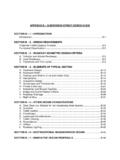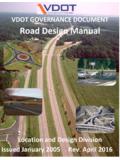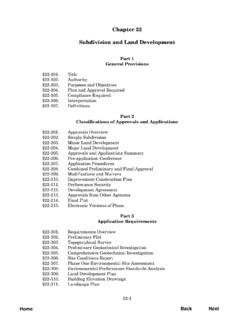Transcription of Requirements for Installation of Underground Electric ...
1 This document is available at FECC Requirements for Installation of Underground Electric Systems in Residential Subdivisions Page 1 of 13 January 2015 Requirements for Installation of Underground Electric Systems in Residential Subdivisions January 2015 This document is available at FECC Requirements for Installation of Underground Electric Systems in Residential Subdivisions Page 2 of 13 January 2015 Contents 1. Purpose .. 4 2. Conditions for Providing Underground Systems .. 4 subdivision Definition .. 4 Feasibility .. 4 Application for Underground Residential subdivision and Cost of Facilities .. 4 Build-Out of subdivision .. 4 Project Development .. 5 3. Electric System Design Guidelines .. 5 Layout and Design .. 5 Environmental Concerns .. 5 Location of Cables and Equipment.
2 5 Use of Overhead Facilities .. 5 Water, Sewer, and Gas Lines .. 5 Telephone & Cable Systems .. 6 Street Lighting .. 6 Sewer Lift Stations .. 6 Temporary Builder s Service .. 6 Service to Homes .. 6 4. Developer s Responsibility for Drawings and Documentation .. 6 Plat Drawings .. 6 Electric Load Information .. 7 Easements .. 7 Covenant Requirements .. 8 Street Lighting .. 8 Final Plat & Bill of Assurance .. 8 5. Developer s Responsibility for Construction .. 8 Property Corners .. 8 Locate Underground Facilities .. 8 This document is available at FECC Requirements for Installation of Underground Electric Systems in Residential Subdivisions Page 3 of 13 January 2015 Excavation .. 9 Road Crossings .. 9 Equipment Locations .. 9 Work Scheduling .. 9 Right-of-Way.
3 9 Changes to Approved Plan .. 9 Service Installations .. 10 Damages to Cooperative Facilities .. 10 6. Cooperative Responsibilities .. 10 Plans and Estimates .. 10 Installation of Primary Distribution Facilities .. 10 Installation of Secondary Distribution Facilities .. 10 Installation of Services .. 10 7. Excavation and Conduit Installation Details .. 11 Typical Multiple Conduit Excavation .. 11 Typical Excavation with Road Crossing .. 12 Typical Road Crossing Conduit Location .. 13 This document is available at FECC Requirements for Installation of Underground Electric Systems in Residential Subdivisions Page 4 of 13 January 2015 1. Purpose This guide is intended for use by property owners, developers, and their engineers who request the Installation of an Underground Electric distribution system to serve a residential subdivision .
4 The developer/owner should contact the Cooperative early in the planning process to obtain a subdivision application and discuss the electrical design Requirements for the project. See also the FECC Member Installation Standards for Electric Service for Requirements on the Installation of Electric service to individual dwellings or premises. 2. Conditions for Providing Underground Systems subdivision Definition A residential subdivision is defined as a tract of land divided into at least 10 lots for single-family residences. Feasibility The Cooperative will provide Underground Electric systems as desired by the developer/owner only if, in the Cooperative s judgment, it is feasible to construct, own, operate, and maintain Underground facilities at the particular location taking into account the terrain conditions and type of load.
5 Application for Underground Residential subdivision and Cost of Facilities The Developer must submit a completed, signed application for the Installation of the Underground system prior to the commencement of the Cooperative s design work. The Developer shall also agree to pay the Cooperative, prior to the commencement of construction work, for the cost of installing Underground facilities in excess of the cost of installing overhead facilities. Build-Out of subdivision Home construction should be done in a period of time deemed reasonable by the Cooperative. In general, the Cooperative expects that 50% of the lots will have homes built and connected to Electric service within 3 years of the development s inception. In cases where the rate of home construction is, in the Cooperative s sole judgment, expected to be less than required by the Cooperative, the Developer shall be required to pay 100% of the construction costs up front as a construction deposit.
6 The deposit (less the amount of the Underground differential cost which shall be non-returnable) shall not accrue interest and will be reimbursed to the Developer as homes are built and connected to Electric service. Such reimbursement shall be made annually for 3 years beginning on the first anniversary of completion of the subdivision s Electric system Installation . The annual reimbursement amount shall be calculated by dividing the initial construction deposit by one-half of the total number of lots within the subdivision , and multiplying that amount by the number of homes completed during the year. Total reimbursements shall not This document is available at FECC Requirements for Installation of Underground Electric Systems in Residential Subdivisions Page 5 of 13 January 2015 exceed the initial deposit, and no reimbursement will be made after the 3rd year.
7 Any deposit remaining after 3 years shall become the property of the Cooperative. Project Development subdivision developments done in phases should be built in contiguous locations that allow economic expansion of the Underground Electric system between the developed areas. Phases built in non-contiguous locations may require additional cost to be paid by the Developer. 3. Electric System Design Guidelines Layout and Design FECC will determine the type of construction and location of line routes and locations of electrical lines, transformers, pedestals, and switchgear. FECC will work with the Developer as far as is practicable to locate such routes and equipment in a manner acceptable to both parties. Requests by the Developer to route lines or locate equipment in locations different from the most economical design as determined by FECC will be considered, and if determined to meet FECC design practices, may be done at additional cost to the Developer.
8 Environmental Considerations Underground Electric facilities shall be routed so as to avoid open drainage ditches, creeks and marsh areas, or other areas that are environmentally sensitive, historically significant, or may hinder construction or operation of the Electric system. Costs associated with areas requiring trench stabilization (retaining walls, concrete encasement, pipe sleeves, rip-rap, etc.) or any required environmental studies shall be paid by the Developer. Location of Cables and Equipment The Underground electrical system generally will run along front lot lines approximately 4 feet behind the property line. Pad-mounted transformers, secondary pedestals and switchgear normally will be located on front lot lines in areas accessible for operation and repairs. Pad-mounted transformers will be placed to allow energized switching operations.
9 The front (lock side) of the transformer normally shall face the street, and requires 12 feet clearance to fences, shrubs, or other obstacles. Use of Overhead Facilities Lots adjacent to overhead lines may be served from pole-mounted transformers with Underground service lines. Water, Sewer, and Gas Lines Water, sewer, or gas lines shall not share the ditch with FECC primary or secondary distribution lines, and shall be separated horizontally by at least 24 inches of undisturbed earth. This document is available at FECC Requirements for Installation of Underground Electric Systems in Residential Subdivisions Page 6 of 13 January 2015 Telephone & Cable Systems Telephone or cable TV lines shall not share FECC s primary or secondary distribution ditch unless the telephone or cable company has a valid joint-trench agreement with FECC.
10 Telephone and cable lines shall be separated horizontally by at least 24 inches of undisturbed earth unless a joint-trench agreement is in place. Street Lighting If street lighting and/or area lighting layouts are required, they shall be designed concurrent with project layout and Installation coordinated with other trenching. Street lighting can be installed only upon execution of an appropriate lighting contract. Sewer Lift Stations Three-phase facilities required for sewer lift stations or other three-phase loads installed in subdivisions that otherwise do not require three-phase service will be paid for at full cost by Developer. See FECC Member Installation Standards for Electric Service. Temporary Builder s Service Temporary service may be furnished from overhead facilities or from pad-mounted transformers.









